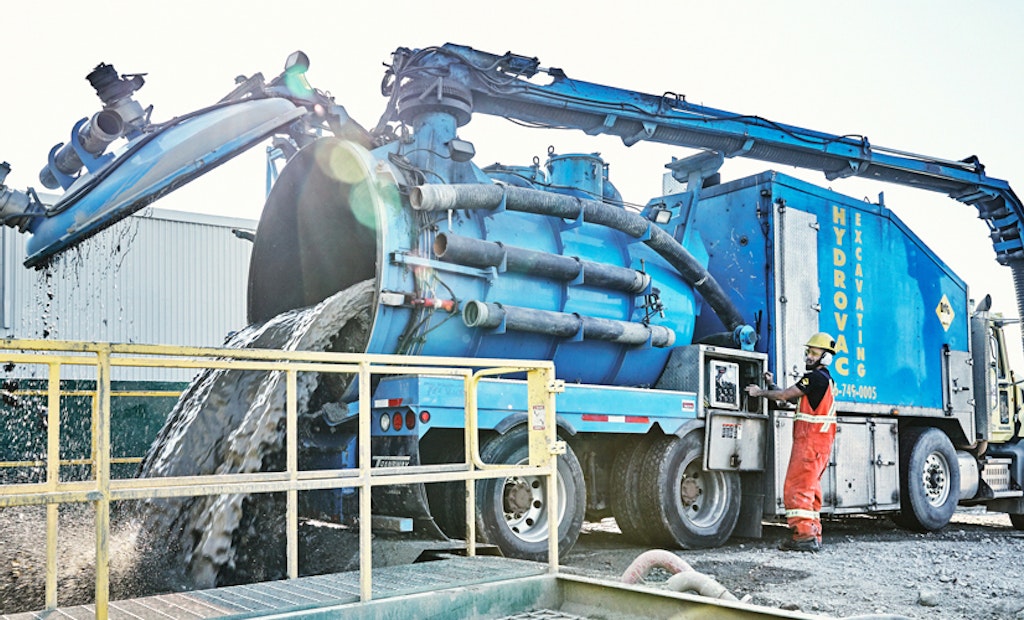Barry Wood knew something had to change. New highway weight restrictions were going into effect in Ontario and his company’s hydroexcavation crews were traveling a lot to dumping facilities.
Ontario Excavac operates 37 hydroexcavation trucks throughout the greater Toronto area.
“The challenge always has been what to do with the spoils,” says Wood, CEO of the company.
Most companies find ways to reuse the water or some of the solids, but rarely do they find reuse for all of the spoils. Wood wanted his company to be different.
So last summer the company opened its own recycling facility. The effect was reduced travel time, reduced overall cost and reuse of all spoils.
A Facility All Their Own
Having a recycling facility also allows crews to quickly off-load if they approach weight limits. Prior to having the facility, trucks would travel several hours out of the city to off-load.
“There were two facilities within the greater Toronto area, but they would work intermittently,” Wood says. “They would have issues with closures during periods of high rainfall and intense cold weather, so they were unreliable.”
The facilities also didn’t have all the approvals Ontario Excavac requires. Because of that, Wood decided it was time to put together the company’s own recycling facility.
Officials from Ontario Excavac spent 2016 looking at various available technologies that could be used in the recycling process. After the technology was selected and modifications were made based on their own knowledge, the recycling facility was installed in spring 2017. After a few months of tests, it went fully operational last summer.
“We’ve been making modifications to it all the way through, removing bottlenecks and improving how material flows through,” Wood says. “It’s been a real learning curve for us.”
Wood admits that his company’s expertise is not in the disposition of soils and managing that, so Ontario Excavac teamed with the owners of Toronto-based Green Soils — a soil remediation company — and built the facility together.
“They look after the soil disposition end of it, the testing of it and disposition of it,” Wood says. “We provide the flow of product to it every day.”
Creating the Flow
When trucks arrive with spoils, they are directed to the back of Ontario Excavac’s headquarters where the recycling facility is. An inclined ramp allows the trucks to back up directly to a hopper. There are enough stations for four hydrovacs to dump.
The hoppers gravity feed the material into vibratory screens that separate some of the larger materials. The remaining materials are mixed with water and pumped into successive stages where different-sized solids are stripped out.
“The technology is borrowed from the mining, oil and gas fracking sector,” Wood says. “We’ve done a lot of work, particularly on the front end of the process to make sure the materials flow properly.”
In the final stage, the silt and clays are removed with a flocculent and centrifuge process, resulting in water that is reusable at about 20 microns of particles. The water can be used to clean out debris tanks or reloaded into the hydrovacs.
“We have borrowed from the wastewater treatment industry as far as the cleanup of the water,” Wood says.
Reusing Materials
Thanks to the technology being used, Ontario Excavac is also able to reuse the silt, aggregates and clays.
“We’re doing some project work with one of our main customers where we’re reusing the silt in the fill,” Wood says. “The aggregates and clays are being used as fill on new construction sites. We’re finding uses for all the materials as opposed to putting them into landfills.”
Many times vacuum excavation companies only look at reusing the water, and possibly upgrading the solids to use them as clean fill for putting into quarries to make them useable land again.
“We decided to go several extra steps where we separate sand material and use the sand as high-performance bedding or in fill,” Wood says. “The biggest challenge in the recycling process is the silts and clays and getting them separated.”
Around the Toronto area, the soil can range from shale and stone to beach-type sand and clays.
More Than Enough Capacity
The recycling center is currently moving about 50 truckloads a day through, but it is capable of handling about 80.
“We’re finding right now that because of the regulatory change and the weight restrictions, it’s going to increase the need to have conveniently located facilities like ours because these trucks will be going overweight partway through the day and they’ll need to unload,” Wood says.
The company has begun to open its facility to others who have hydroexcavators.
“One of our major customers uses a lot of hydrovacs, and we’ve opened it up to their other hydrovac suppliers,” Wood says. “We have first dibs on capacity, but we’re at a stage now where we can pretty comfortably open it up to other companies.”
Wood says having a recycling facility is a win on many fronts for the company.
“What we’re finding is by doing this we have a win-win situation here,” Wood says. “We’ve been able to show environmental leadership in terms of dealing with material and repurposing it, but at the same time, our customers are getting the benefit of cost-savings from eliminating unnecessary travel to a distant landfill site. We’re also able to offer materials back to them at a discount.”






